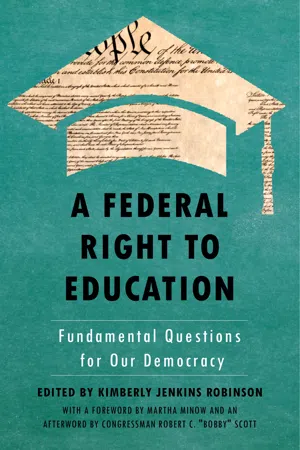
A Federal Right to Education
Fundamental Questions for Our Democracy
- English
- ePUB (mobile friendly)
- Available on iOS & Android
About this book
How the United States can provide equal educational opportunity to every child
The United States Supreme Court closed the courthouse door to federal litigation to narrow educational funding and opportunity gaps in schools when it ruled in San Antonio Independent School District v. Rodriguez in 1973 that the Constitution does not guarantee a right to education. Rodriguez pushed reformers back to the state courts where they have had some success in securing reforms to school funding systems through education and equal protection clauses in state constitutions, but far less success in changing the basic structure of school funding in ways that would ensure access to equitable and adequate funding for schools. Given the limitations of state school funding litigation, education reformers continue to seek new avenues to remedy inequitable disparities in educational opportunity and achievement, including recently returning to federal court.
This book is the first comprehensive examination of three issues regarding a federal right to education: why federal intervention is needed to close educational opportunity and achievement gaps; the constitutional and statutory legal avenues that could be employed to guarantee a federal right to education; and, the scope of what a federal right to education should guarantee. A Federal Right to Education provides a timely and thoughtful analysis of how the United States could fulfill its unmet promise to provide equal educational opportunity and the American Dream to every child, regardless of race, class, language proficiency, or neighborhood.
Frequently asked questions
- Essential is ideal for learners and professionals who enjoy exploring a wide range of subjects. Access the Essential Library with 800,000+ trusted titles and best-sellers across business, personal growth, and the humanities. Includes unlimited reading time and Standard Read Aloud voice.
- Complete: Perfect for advanced learners and researchers needing full, unrestricted access. Unlock 1.4M+ books across hundreds of subjects, including academic and specialized titles. The Complete Plan also includes advanced features like Premium Read Aloud and Research Assistant.
Please note we cannot support devices running on iOS 13 and Android 7 or earlier. Learn more about using the app.
Information
Part I
Why the United States Should (or Should Not) Consider Recognizing a Federal Right to Education
1
The Justifications for a Stronger Federal Response to Address Educational Inequalities
Introduction
Table of contents
- Cover
- Title Page
- Copyright Page
- Contents
- Foreword. “The Whole People Must Take Upon Themselves the Education of the Whole People”
- Introduction. The Essential Questions Regarding a Federal Right to Education
- Part I. Why the United States Should (or Should Not) Consider Recognizing a Federal Right to Education
- Part II. How the United States Could Recognize a Federal Right to Education
- Part III. What a Federal Right to Education Should Guarantee
- Acknowledgments
- About the Editor
- About the Contributors
- Index